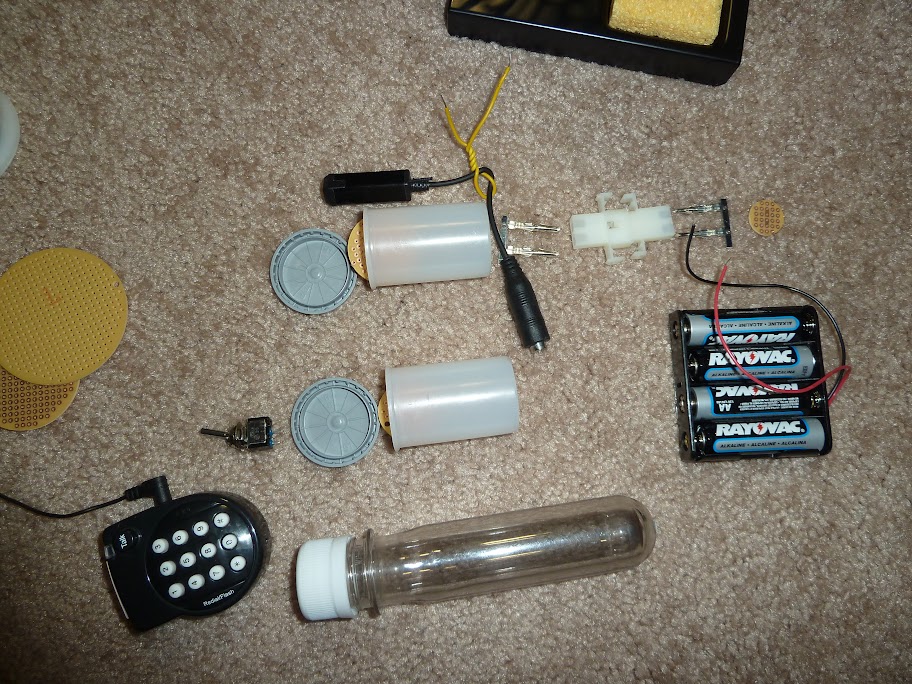


Disassembled shells and copper burst disks.
* Loading - When I started out the project I wanted to stay at least 20% below both legal and safety thresholds for the amount of propellant. The camera capsule contains only electronic/reconnaissance package. All the powder is in the high pressure chamber. This loading max was the basis for all my calculations from that point on.
The shells we are utilizing use a highpessure/low pressure system design. The burst disk controls the maximum pressure reached in the pressure chamber, the size of the vent holes controls the pressure in the low pressure chamber
* Payload Package - I experimented with various payload packages. Initial tests were conducted with 35mm film canisters. Initial tests were positive however it quickly became apparent that the containers were not aerodynamically stable enough, and were spacious enough to accommodate the appropriate power source.
Further testing was done with nalgene mini bottles. At this stage the most promising candidate is the baby soda bottle.




Some pictures of various test capsules being prepared for assembly.

Top left - empty casing from a 37mm batton round. I was attempting to reload it with the camera round but the primer was a pain in the butt to load, and the thin walls made me scrap that idea.
Bottom left - tactical DVR with LCD. To the right of it is the cold zone/command post receiver.
Above the cold zone receiver is the camera module with connector prong, 2 button cell batteries are between the wires.
Far right - parachute that ended up being way too large for the capsule, also parachute is too large for the capsule weight and anticipated wind.
* Stabilization - Initial design called for spring-open fin design. While great in on the whiteboard, reliably deploying fins while the system is fired under variety of conditions and at variety of angles.
The initial great design was sidelined for now in favor of designs that utilize streamers. Streamers not only stabilize the camera but also help slow it down to a velocity where the camera output can be easily perceived by unaided eye without needing to rewind and rewatch video several times.
* Deceleration - The camera is initially fired at a fairly high velocity (>650fps) while quite slow for a round it is way to fast for a video camera. The camera gains altitude during the boost phase and must then be slowed down to a point where the camera can keep up.
The main deceleration is accomplished with a small fire-resistant parachute. Initial designs utilized a larger parachute but the deployment proved to be less reliable and too space inefficient.
The parachute also ensures the camera is properly oriented to send back video shortly before the apogee, and the entire time of descent.
Slower velocities help make the round safer for use around crowds and particularly unsuitable for anti-personnel use and help reinforce it's non-DD purpose and legal status.
Once the chute is deployed the camera capsule is slowed down to < 250FPS.
* Arming - Once the power is applied the camera is live, and broadcasting video.
Needless to say this was unacceptable due to low battery lifetime. We needed an arming mechanism. The M203 uses a spin-arm mechanism. While very cool concept it is unreliable and totally unfeasible for our civilian smooth-bore barrel.
I experimented with various designs including reed switches, magnets, arming plugs, keyed arming plugs, push switches, pull-pin/ripcord designs. An acceptable solution that allows for the capsule to remain waterproof, reliable, and for the camera to be activated prior to be firing is yet to be worked out.
Some testing was done with mini-arduino and 3 axis accelerometer. While working and cool it is not feasible in 37mm version due to power requirements and space constraints. I am sidelining this possibility (for now).
* Cameras - Camera systems are Josh's specialty and he has been working on various possibilities. After some trial and error 5.8GHz spectrum was decided upon. Range was tested to 350ft in urban environment.
* DVRs - After some research josh has settled on a 2 prong approach - a tactical receiver which can be worn on the arm band, attached to hook and pile etc by the tactical team. The tactical receiver records to a high capacity micro SD card for replay and evidentiary purposes.
The 2nd receiver is a high-power long range receiver with standard AV out. this unit would be placed in the mobile command post/cold zone.
No comments:
Post a Comment